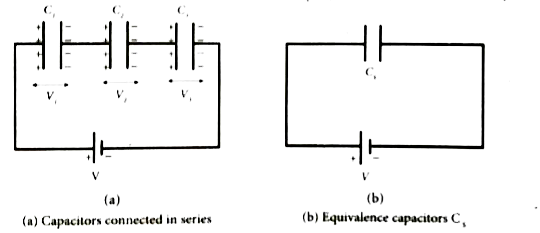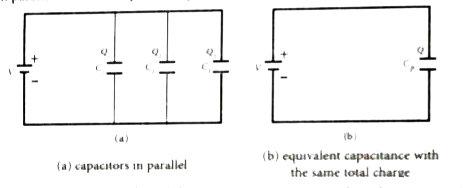Derive the expression for resultant capacitance when capacitors are connected in series and in parallel . Solution in Tamil
Capacitor in series and parallel:
(i) Capacitor in series : Consider three capacitors of capacitance C1,C2 and C3 connected in series with a battery of voltage V as shown in the figure (a). As soon as the battery is connected to the capacitor in series the electrons of charge -Q are transferred from negative terminal to the right plate of C3 which pushes the electrons of same amount (−Q) from left plate of C3 to the right plate of C2 due to electrostatic induction. Similarly the left plate of C2 pushes the charges of (−Q) to the right plate of C1 which induces the positive charge (+O) on the left plate of C1 . At the same time electrons of charge (−Q) are transferred from left plate of C1 to positive terminal of the battery .

By these processes each capacitor stores the same amount of charge Q. The capacitances of the capacitors are in general different so that the voltage across each capacitor is also different and are denoted as V1,V2 and V3 respectively .
The total voltage across each capacitor must be equal to the voltage of the a battery.
V=V1+V2+V3
Since Q=CV we have V=QC1+QC2+QC3
=Q(1C1+1C2+1C3)
If three capacitors in series are considered to form an equivalent single capacitor C5
shown in figure (b) then we have V=QCs
Substituting this expression into equation (2) we get
QCs=Q(1C1+1C2+1C3)
1Cs=1C1+1C2+1C3
Thus the inverse of the equivalent capacitance Cs of three capacitors connected in series is equal to the sum of the inverses of each capacitance . This equivalent capacitance Cs is always less than the smallest individual capacitance in the series.
(ii) Capacitance in parallel : Consider three capacitors of capacitance C1,C2 and C3 connected in parallel with a battery of voltage V as shown in figure (a)

Since corresponding sides of the capacitors are connected to the same positive and negative terminals of the battery the voltage across each capacitor is equal to the battery.s voltage . Since capacitance of the capacitors is different the charge stored in each capacitor is not the same . Let the charge stored in the three capacitors be Q1,Q3 and Q3 respectively . According to the law of conservation of total charge the sum of these three charges is equal to the charge Q transferred by the battery,
Q=Q1+Q2+Q3
Now since Q= CV we have
Q=C1V+C2V+C3V
If these three capacitors are considered to form a single capacitance Cp which stores the total charge Q as shown in the figure (b) then we can write Q= CPV . Substituting this in equation (2) 2we get
CpV=C1V+C2V+C3V
Thus the equivalent capacitance of capacitors connected in parallel is equal to the sum of the individual capacitances . The equivalent capacitance Cp in a parallel connected is always greater than than the largest individual capacitance. In a parallel connection it is equivalent as area of each capacitance adds to give more effective area such that total capacitance increases.
Similar Questions
Derive expresion for capacitance of a parallel plate capacitor and explain the combination of capacitors in series. Or. Write expression for three capacitors in series and parallel combinations.
View SolutionDerive an expression for the effective capacitance of three capacitors connected in parallel.
View SolutionThree capacitors, each of capacitance 0.3μF, are connected in parallel. This combination is connected with another capacitor of capacitance 0.1μF in series. What is the resultant capacitance?
View SolutionDerive an expression for the equivalent capacitance when capacitors are connected in parallel.
View SolutionDerive an expressions for effective capacitance of capacitors connected in series,
View SolutionDerive an expressions for effective capacitance of capacitors connected in parallel.
View SolutionThree capacitors, each of capacitance 0.3 muF are connected in parallel. This combination is connected with another capacitor of capacitance 0.1 muF in series. What is the resultant capacitance?
View Solution
